transtips翻译技巧入门
- 格式:docx
- 大小:14.14 KB
- 文档页数:13
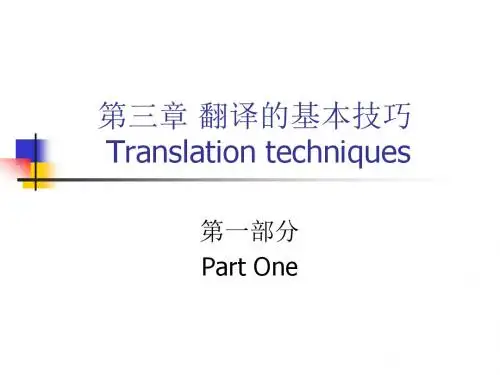
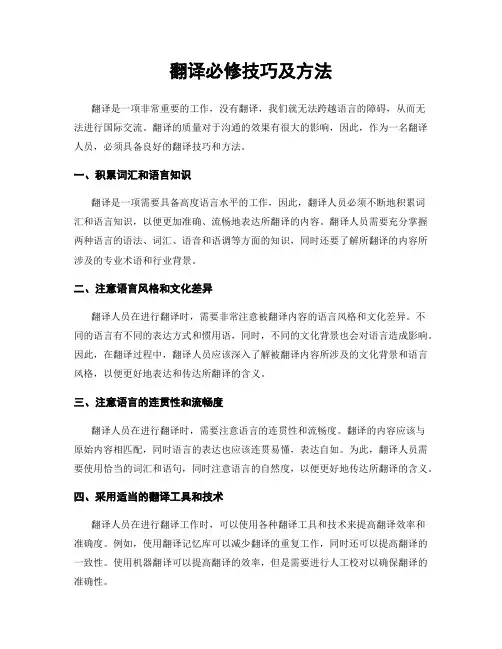
翻译必修技巧及方法翻译是一项非常重要的工作,没有翻译,我们就无法跨越语言的障碍,从而无法进行国际交流。
翻译的质量对于沟通的效果有很大的影响,因此,作为一名翻译人员,必须具备良好的翻译技巧和方法。
一、积累词汇和语言知识翻译是一项需要具备高度语言水平的工作,因此,翻译人员必须不断地积累词汇和语言知识,以便更加准确、流畅地表达所翻译的内容。
翻译人员需要充分掌握两种语言的语法、词汇、语音和语调等方面的知识,同时还要了解所翻译的内容所涉及的专业术语和行业背景。
二、注意语言风格和文化差异翻译人员在进行翻译时,需要非常注意被翻译内容的语言风格和文化差异。
不同的语言有不同的表达方式和惯用语,同时,不同的文化背景也会对语言造成影响。
因此,在翻译过程中,翻译人员应该深入了解被翻译内容所涉及的文化背景和语言风格,以便更好地表达和传达所翻译的含义。
三、注意语言的连贯性和流畅度翻译人员在进行翻译时,需要注意语言的连贯性和流畅度。
翻译的内容应该与原始内容相匹配,同时语言的表达也应该连贯易懂,表达自如。
为此,翻译人员需要使用恰当的词汇和语句,同时注意语言的自然度,以便更好地传达所翻译的含义。
四、采用适当的翻译工具和技术翻译人员在进行翻译工作时,可以使用各种翻译工具和技术来提高翻译效率和准确度。
例如,使用翻译记忆库可以减少翻译的重复工作,同时还可以提高翻译的一致性。
使用机器翻译可以提高翻译的效率,但是需要进行人工校对以确保翻译的准确性。
总结:翻译是一项非常复杂的工作,需要翻译人员具备高度的语言水平和丰富的专业知识。
在翻译过程中,需要注意词汇和语言的积累,注意语言风格和文化差异,重视语言连贯性和流畅度,同时采用适当的翻译工具和技术。
翻译人员需要不断地提高自己的翻译技巧和方法,以便更好地完成翻译工作,为国际交流发挥积极的作用。
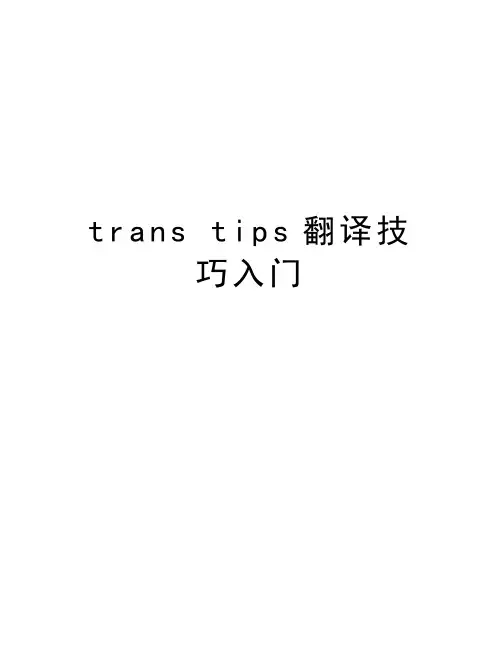
t r a n s t i p s翻译技巧入门1.中英文定语位置的差别?中:定语+主语英:主语+定语2.英译汉的主要步骤?断句+翻译+重读3.英中介词翻译成中文的什么词性?方位adv.&v.4.中英文句式差异?中:句子较短重点在后多用标点主语+废话+最重要成分英:句子较长重点在前不重视标点主语+最重要成分+废话{Ps 废话:定从,状从,补语,同位语} 5.定从的几种译法?<8个词-------定从+先行词“……的…”>8个词-------先行词,that/which具体指代内容+定从内容至于前置还是后置,根据8词原则。
6.循环套句用定语从句是什么?怎么翻译?中心词+定从1+定从2+定从3+.........①.定从1+定从2==定从3:1,2和在一块翻译②.定从2+定从3==定从1:2,3合在一起翻译7.需要断句的长句和不需要断句的长句怎么翻?大长句,有好多定语,很少标点:断句+翻译+重读一堆小短句,从前往后简单易懂,很多短句:断句+找重点句和微弱逻辑关系+翻译+重读第二课8.什么是定从的“并列套用”和“循环套用”?区别?怎么翻?并列套用:中心词+定从1+定从2+…and+定从n循环套用:中心词+定从1+定从2+…+定从n区别:并列套用:每个定从都修饰中心词且是并列关系用and连接循环套用:每个定从的先行词都在前一个定从里环环相扣翻译:并列套用:后置译法关系词只翻译一次循环套用:①.定从1+定从2==定从3:1,2合在一块翻译②.定从2+定从3==定从1:2,3合在一起翻译9.中文里的本位词?末位词?怎么翻?本位词:e.g. 这这样这些末位词:被本位词替代的部分翻译:本位词取代末位词要不然中文句子就太长了10.英文中四种句子类型?怎么翻?①长句多标点专有名词生词多——按顺序翻+注意查词准确+重读②长句少标点多从句插入语——断句+翻译+重读③长句多标点——断句+分析句句微弱逻辑关系+重读④短句——再短变中文都要加标点+重读11.中英文事实和评论的关系?怎么翻?中:事实+评论英:评论+事实按中英文习惯翻12.中英文关联词使用原则/中:虽然……,但是……英:①虽然……,……②……,但是……13.谓语动词的过度?例如?英到中:意思微弱的v不用翻译出来中到英:补微弱v词只要中文中出现adv+v,翻英时就把adv变为v,把v变为n e.g.加快建立rapid the foundation of...例如:我支持你I support you.I give you a support.——谓动过度。
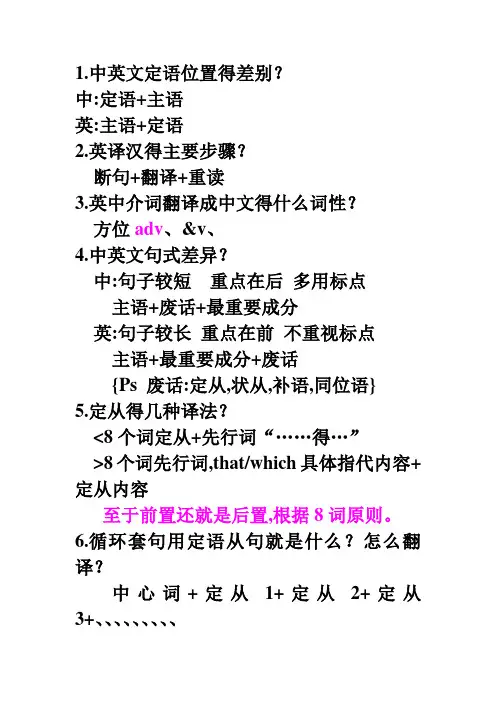
1.中英文定语位置得差别?中:定语+主语英:主语+定语2.英译汉得主要步骤?断句+翻译+重读3.英中介词翻译成中文得什么词性?方位adv、&v、4.中英文句式差异?中:句子较短重点在后多用标点主语+废话+最重要成分英:句子较长重点在前不重视标点主语+最重要成分+废话{Ps 废话:定从,状从,补语,同位语}5.定从得几种译法?<8个词定从+先行词“……得…”>8个词先行词,that/which具体指代内容+定从内容至于前置还就是后置,根据8词原则。
6.循环套句用定语从句就是什么?怎么翻译?中心词+定从1+定从2+定从3+、、、、、、、、、①、定从1+定从2==定从3:1,2与在一块翻译②、定从2+定从3==定从1:2,3合在一起翻译7、需要断句得长句与不需要断句得长句怎么翻?大长句,有好多定语,很少标点:断句+翻译+重读一堆小短句,从前往后简单易懂,很多短句:断句+找重点句与微弱逻辑关系+翻译+重读第二课8、什么就是定从得“并列套用”与“循环套用”?区别?怎么翻?并列套用:中心词+定从1+定从2+…and+定从n 循环套用:中心词+定从1+定从2+…+定从n区别:并列套用:每个定从都修饰中心词且就是并列关系用and连接循环套用:每个定从得先行词都在前一个定从里环环相扣翻译:并列套用:后置译法关系词只翻译一次循环套用:①、定从1+定从2==定从3:1,2合在一块翻译②、定从2+定从3==定从1:2,3合在一起翻译9.中文里得本位词?末位词?怎么翻?本位词:e、g、这这样这些末位词:被本位词替代得部分翻译:本位词取代末位词要不然中文句子就太长了10.英文中四种句子类型?怎么翻?①长句多标点专有名词生词多——按顺序翻+注意查词准确+重读②长句少标点多从句插入语——断句+翻译+重读③长句多标点——断句+分析句句微弱逻辑关系+重读④短句——再短变中文都要加标点+重读11.中英文事实与评论得关系?怎么翻?中:事实+评论英:评论+事实按中英文习惯翻12.中英文关联词使用原则/中:虽然……,但就是……英:①虽然……,……②……,但就是……13.谓语动词得过度?例如?英到中:意思微弱得v不用翻译出来中到英:补微弱v词只要中文中出现adv+v,翻英时就把adv变为v, 把v变为n e、g、加快建立rapid the foundation of、、、例如:我支持您I support you、I give you a support、——谓动过度。
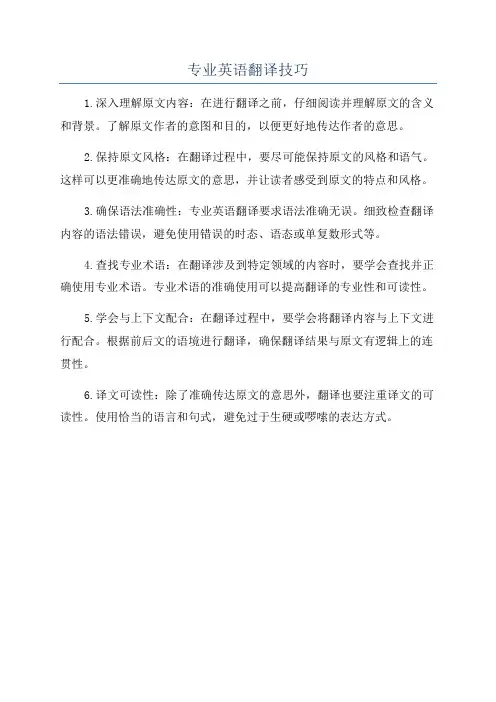
专业英语翻译技巧
1.深入理解原文内容:在进行翻译之前,仔细阅读并理解原文的含义和背景。
了解原文作者的意图和目的,以便更好地传达作者的意思。
2.保持原文风格:在翻译过程中,要尽可能保持原文的风格和语气。
这样可以更准确地传达原文的意思,并让读者感受到原文的特点和风格。
3.确保语法准确性:专业英语翻译要求语法准确无误。
细致检查翻译内容的语法错误,避免使用错误的时态、语态或单复数形式等。
4.查找专业术语:在翻译涉及到特定领域的内容时,要学会查找并正确使用专业术语。
专业术语的准确使用可以提高翻译的专业性和可读性。
5.学会与上下文配合:在翻译过程中,要学会将翻译内容与上下文进行配合。
根据前后文的语境进行翻译,确保翻译结果与原文有逻辑上的连贯性。
6.译文可读性:除了准确传达原文的意思外,翻译也要注重译文的可读性。
使用恰当的语言和句式,避免过于生硬或啰嗦的表达方式。
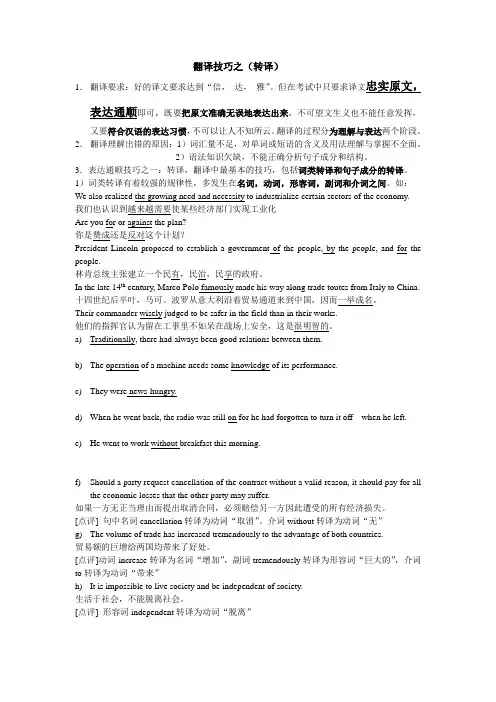
翻译技巧之(转译)1.翻译要求:好的译文要求达到“信,达,雅”。
但在考试中只要求译文忠实原文,表达通顺即可,既要把原文准确无误地表达出来,不可望文生义也不能任意发挥,又要符合汉语的表达习惯,不可以让人不知所云。
翻译的过程分为理解与表达两个阶段。
2.翻译理解出错的原因:1)词汇量不足,对单词或短语的含义及用法理解与掌握不全面。
2)语法知识欠缺,不能正确分析句子成分和结构。
3.表达通顺技巧之一:转译,翻译中最基本的技巧,包括词类转译和句子成分的转译。
1)词类转译有着较强的规律性,多发生在名词,动词,形容词,副词和介词之间。
如:We also realized the growing need and necessity to industrialize certain sectors of the economy.我们也认识到越来越需要使某些经济部门实现工业化Are you for or against the plan?你是赞成还是反对这个计划?President Lincoln proposed to establish a government of the people, by the people, and for the people.林肯总统主张建立一个民有,民治,民享的政府。
In the late 14th century, Marco Polo famously made his way along trade toutes from Italy to China. 十四世纪后半叶,马可。
波罗从意大利沿着贸易通道来到中国,因而一举成名。
Their commander wisely judged to be safer in the field than in their works.他们的指挥官认为留在工事里不如呆在战场上安全,这是很明智的。
a)Traditionally, there had always been good relations between them.___________________________________________________________________________b)The operation of a machine needs some knowledge of its performance.___________________________________________________________________________c)They were news-hungry.____________________________________________________________________________ d)When he went back, the radio was still on for he had forgotten to turn it off when he left.____________________________________________________________________________ e)He went to work without breakfast this morning.____________________________________________________________________________f)Should a party request cancellation of the contract without a valid reason, it should pay for allthe economic losses that the other party may suffer.如果一方无正当理由而提出取消合同,必须赔偿另一方因此遭受的所有经济损失。
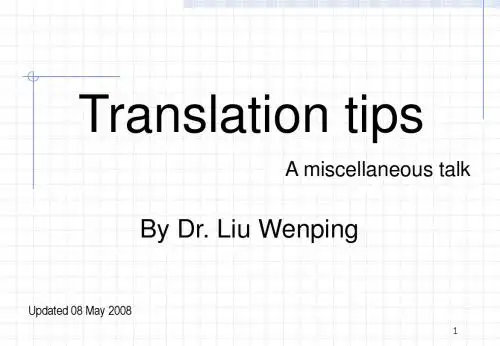
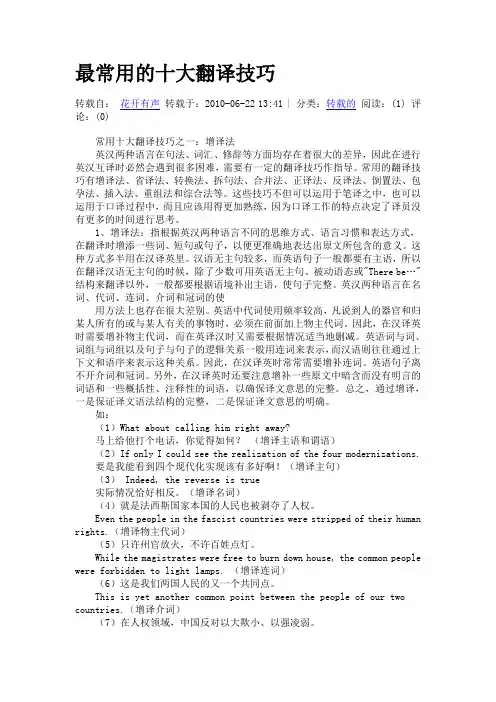
最常用的十大翻译技巧转载自:花开有声转载于:2010-06-22 13:41 | 分类:转载的阅读:(1) 评论:(0)常用十大翻译技巧之一:增译法英汉两种语言在句法、词汇、修辞等方面均存在着很大的差异,因此在进行英汉互译时必然会遇到很多困难,需要有一定的翻译技巧作指导。
常用的翻译技巧有增译法、省译法、转换法、拆句法、合并法、正译法、反译法、倒置法、包孕法、插入法、重组法和综合法等。
这些技巧不但可以运用于笔译之中,也可以运用于口译过程中,而且应该用得更加熟练,因为口译工作的特点决定了译员没有更多的时间进行思考。
1、增译法:指根据英汉两种语言不同的思维方式、语言习惯和表达方式,在翻译时增添一些词、短句或句子,以便更准确地表达出原文所包含的意义。
这种方式多半用在汉译英里。
汉语无主句较多,而英语句子一般都要有主语,所以在翻译汉语无主句的时候,除了少数可用英语无主句、被动语态或"There be…"结构来翻译以外,一般都要根据语境补出主语,使句子完整。
英汉两种语言在名词、代词、连词、介词和冠词的使用方法上也存在很大差别。
英语中代词使用频率较高,凡说到人的器官和归某人所有的或与某人有关的事物时,必须在前面加上物主代词。
因此,在汉译英时需要增补物主代词,而在英译汉时又需要根据情况适当地删减。
英语词与词、词组与词组以及句子与句子的逻辑关系一般用连词来表示,而汉语则往往通过上下文和语序来表示这种关系。
因此,在汉译英时常常需要增补连词。
英语句子离不开介词和冠词。
另外,在汉译英时还要注意增补一些原文中暗含而没有明言的词语和一些概括性、注释性的词语,以确保译文意思的完整。
总之,通过增译,一是保证译文语法结构的完整,二是保证译文意思的明确。
如:(1)What about calling him right away?马上给他打个电话,你觉得如何?(增译主语和谓语)(2)If only I could see the realization of the four modernizations.要是我能看到四个现代化实现该有多好啊!(增译主句)(3) Indeed, the reverse is true实际情况恰好相反。
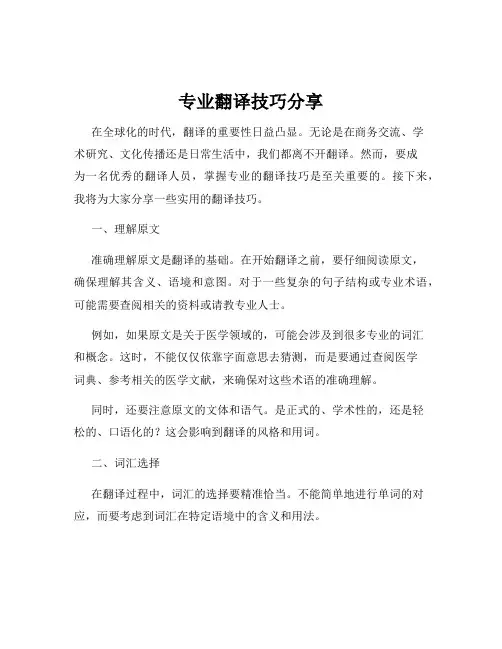
专业翻译技巧分享在全球化的时代,翻译的重要性日益凸显。
无论是在商务交流、学术研究、文化传播还是日常生活中,我们都离不开翻译。
然而,要成为一名优秀的翻译人员,掌握专业的翻译技巧是至关重要的。
接下来,我将为大家分享一些实用的翻译技巧。
一、理解原文准确理解原文是翻译的基础。
在开始翻译之前,要仔细阅读原文,确保理解其含义、语境和意图。
对于一些复杂的句子结构或专业术语,可能需要查阅相关的资料或请教专业人士。
例如,如果原文是关于医学领域的,可能会涉及到很多专业的词汇和概念。
这时,不能仅仅依靠字面意思去猜测,而是要通过查阅医学词典、参考相关的医学文献,来确保对这些术语的准确理解。
同时,还要注意原文的文体和语气。
是正式的、学术性的,还是轻松的、口语化的?这会影响到翻译的风格和用词。
二、词汇选择在翻译过程中,词汇的选择要精准恰当。
不能简单地进行单词的对应,而要考虑到词汇在特定语境中的含义和用法。
有时候,一个单词可能有多个意思,要根据上下文选择最合适的释义。
比如“address”这个单词,既可以表示“地址”,也可以表示“处理、解决”。
此外,还要注意词汇的搭配和惯用表达。
比如,“make a decision”是“做决定”,而不是“do a decision”。
对于一些没有完全对应的词汇,可以采用释义、加注或者借用类似概念的词汇等方法。
但要避免生造词汇,以免造成误解。
三、句子结构调整由于不同语言的句子结构存在差异,在翻译时常常需要对句子结构进行调整。
比如,英语中常常使用从句和长句,而中文则更倾向于使用短句和简单句。
在将英语翻译成中文时,可能需要将长句拆分成几个短句,使其更符合中文的表达习惯。
例如:“The book which I bought yesterday is very interesting”可以翻译成“我昨天买的那本书非常有趣。
” 这里将英语中的定语从句拆分成了一个短句。
同时,还要注意语序的调整。
比如,在英语中,时间状语和地点状语的位置比较灵活,而在中文中通常会放在句子的前面。
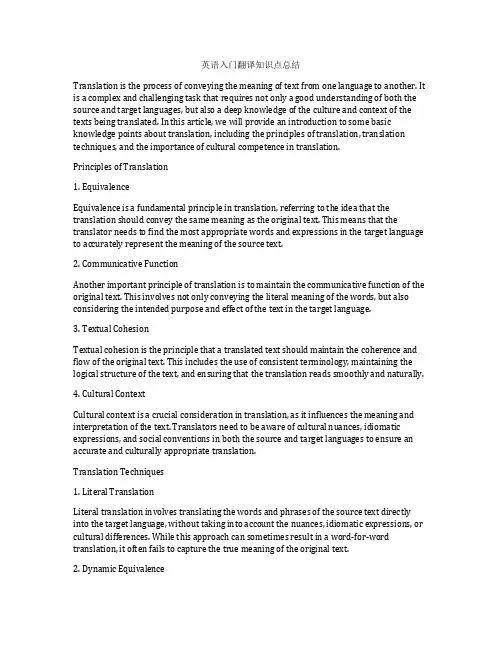
英语入门翻译知识点总结Translation is the process of conveying the meaning of text from one language to another. It is a complex and challenging task that requires not only a good understanding of both the source and target languages, but also a deep knowledge of the culture and context of the texts being translated. In this article, we will provide an introduction to some basic knowledge points about translation, including the principles of translation, translation techniques, and the importance of cultural competence in translation.Principles of Translation1. EquivalenceEquivalence is a fundamental principle in translation, referring to the idea that the translation should convey the same meaning as the original text. This means that the translator needs to find the most appropriate words and expressions in the target language to accurately represent the meaning of the source text.2. Communicative FunctionAnother important principle of translation is to maintain the communicative function of the original text. This involves not only conveying the literal meaning of the words, but also considering the intended purpose and effect of the text in the target language.3. Textual CohesionTextual cohesion is the principle that a translated text should maintain the coherence and flow of the original text. This includes the use of consistent terminology, maintaining the logical structure of the text, and ensuring that the translation reads smoothly and naturally.4. Cultural ContextCultural context is a crucial consideration in translation, as it influences the meaning and interpretation of the text. Translators need to be aware of cultural nuances, idiomatic expressions, and social conventions in both the source and target languages to ensure an accurate and culturally appropriate translation.Translation Techniques1. Literal TranslationLiteral translation involves translating the words and phrases of the source text directly into the target language, without taking into account the nuances, idiomatic expressions, or cultural differences. While this approach can sometimes result in a word-for-word translation, it often fails to capture the true meaning of the original text.2. Dynamic EquivalenceDynamic equivalence, also known as functional equivalence, is a translation technique that focuses on conveying the meaning and communicative function of the original text, rather than a literal rendering of the words. This approach allows for greater flexibility in the translation process, as it prioritizes the overall meaning and impact of the text in the target language.3. TranscreationTranscreation is a technique used for creative and highly expressive texts, such as marketing materials, slogans, and literary works. It involves adapting the original text in such a way that the same impact, emotion, and intent are conveyed in the target language, rather than a direct translation of the words.4. LocalizationLocalization is a technique that involves adapting a translation to suit the cultural and linguistic conventions of a specific region or target audience. This may include adapting dates, currencies, measurements, and cultural references to make the translation more relevant and accessible to the target audience.Importance of Cultural Competence in TranslationCultural competence is a critical skill for translators, as it enables them to accurately convey the nuances and cultural references of the source text in the target language. It involves not only an understanding of the language itself, but also the customs, traditions, and social norms of the cultures involved. Without cultural competence, translations may miss important nuances, appear unnatural, or even cause offense to the target audience.In conclusion, translation is a complex and multifaceted process that requires a deep understanding of both the source and target languages, as well as the cultural and contextual factors involved. By applying the principles of equivalence, maintaining communicative function, ensuring textual cohesion, and considering cultural context, translators can create accurate, meaningful, and culturally appropriate translations. Developing cultural competence and mastering various translation techniques are essential for producing high-quality translations that effectively convey the meaning and impact of the original text in the target language.。
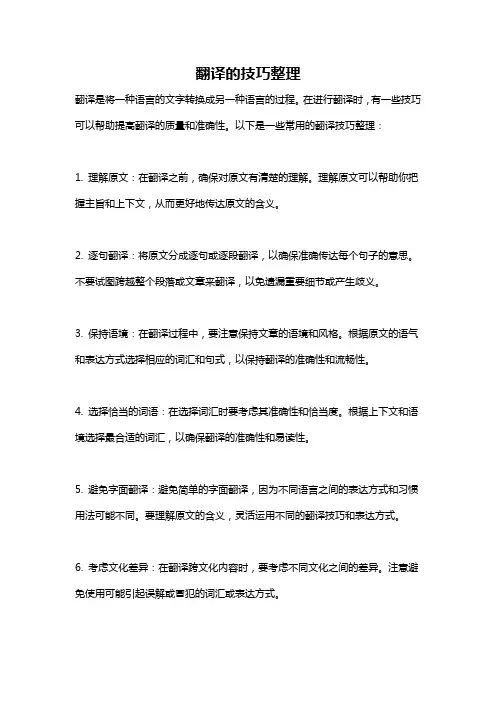
翻译的技巧整理
翻译是将一种语言的文字转换成另一种语言的过程。
在进行翻译时,有一些技巧可以帮助提高翻译的质量和准确性。
以下是一些常用的翻译技巧整理:
1. 理解原文:在翻译之前,确保对原文有清楚的理解。
理解原文可以帮助你把握主旨和上下文,从而更好地传达原文的含义。
2. 逐句翻译:将原文分成逐句或逐段翻译,以确保准确传达每个句子的意思。
不要试图跨越整个段落或文章来翻译,以免遗漏重要细节或产生歧义。
3. 保持语境:在翻译过程中,要注意保持文章的语境和风格。
根据原文的语气和表达方式选择相应的词汇和句式,以保持翻译的准确性和流畅性。
4. 选择恰当的词语:在选择词汇时要考虑其准确性和恰当度。
根据上下文和语境选择最合适的词汇,以确保翻译的准确性和易读性。
5. 避免字面翻译:避免简单的字面翻译,因为不同语言之间的表达方式和习惯用法可能不同。
要理解原文的含义,灵活运用不同的翻译技巧和表达方式。
6. 考虑文化差异:在翻译跨文化内容时,要考虑不同文化之间的差异。
注意避免使用可能引起误解或冒犯的词汇或表达方式。
7. 反复检查和修正:在完成翻译后,进行反复检查和修正,以确保语法、拼写和表达的准确性和流畅性。
对疑惑或不确定的地方进行进一步的研究和验证。
8. 不断学习和提高:翻译是一个不断学习和提高的过程。
保持学习和积累翻译技巧,了解语言的变化和发展,以提高自己的翻译能力。
总之,翻译是一项艰巨但有趣的任务。
通过理解原文,保持语境,选择恰当的词语和灵活运用翻译技巧,可以提高翻译的质量和准确性,确保翻译的命中度和传达效果。
常用翻译技巧四、采用口语化表达在翻译中文时,尽量采用口语化的表达方式,使翻译出来的内容更符合日常口语的习惯。
这样的翻译更易于被目标读者所理解和接受。
以下是一些常见的口语化表达技巧:1.使用常见的口语词汇和短语:在选择词汇和短语的时候,可以更倾向于常见的口语表达方式。
比如,将"因为"翻译为"因为"而不是"由于",将"没有"翻译为"没有"而不是"无"。
2.使用常见的口语句式:在译文中,可以使用一些常见的口语句式,使翻译更贴近日常口语的表达方式。
比如,将"我不知道"翻译为"我不知道"而不是"我不晓得"。
3.使用常见的口语语气助词:在翻译过程中,适当地使用一些常见的口语语气助词,可以有效地增强语气表达,使译文更加生动有趣。
比如,将"他很快地跑了过来"翻译为"他迅速地跑过来"或"他飞快地跑过来"。
4.注意简洁明了:口语表达方式通常比书面语更简洁明了,所以在翻译中要尽量简化句子结构,去除冗余词汇,使表达更清晰明了。
比如,将"在下个星期的周五"翻译为"下周五",将"我会马上回来"翻译为"我马上回来"。
5.保持语法结构的简单:口语化的翻译通常采用简单的语法结构,避免使用过于复杂的从句或长句。
这样可以使翻译更容易理解和接受。
比如,将"她告诉我,她会找个时间约我出去玩"翻译为"她告诉我她会找时间跟我出去玩"。
总之,采用口语化表达是一种有效的翻译技巧,能够使翻译更贴近日常口语的表达方式,更易于被读者所理解和接受。
但需要注意的是,口语化表达要适度,不要过度运用,以免影响翻译的准确性和专业性。
课学习基本的翻译技巧
学习翻译技巧是提高语言能力的重要途径,不仅可以帮助读者更好地理解原文,还可以提高自己的表达能力。
以下是一些学习翻译技巧的方法。
一、了解背景知识
学习翻译技巧前,必须要了解相关的背景知识。
比如如果要翻译医学文献,就需要了解医学方面的专业术语,否则会对翻译造成很大的困难。
二、掌握翻译原则
在翻译过程中,要遵循一定的翻译原则,比如要忠实于原文,不要添加自己的观点,也要尽量保留原文的语言风格。
三、注意语言表达
在翻译过程中,还需要注意语言表达的准确性。
如果原文中有一些文化差异或者语言难度高的表达,需要在翻译时进行适当的转换和解释。
四、注意场景语境
在翻译过程中,还需要注意场景语境的变化。
比如在翻译旅游宣传资料时,就需要根据不同的目的地和文化背景进行翻译,以便更好地达到宣传效果。
五、使用翻译工具
学习使用翻译工具也是提高翻译水平的重要方法。
比如可以使用在
线翻译工具、翻译软件或手册等,以帮助自己更好地理解原文并提高
翻译速度。
以上是学习基本的翻译技巧的几个方面,学习翻译技巧需要不断的
进行实践和锻炼,只有经过大量的实践才能真正提高自己的翻译水平。
翻译的技巧由于英汉两种语言在词法和句法上存在着巨大的差异,其次,中西方的语言文化背景方面也存在着不逾越的鸿沟,所以在互译方面就会存在着很多的问题。
很多翻译大家都着重强调翻译最重要的一点就是要学会灵活变通。
所谓的灵活变通就不得提到翻译时常用的各种方法和技巧。
书中在这一方面着重列举了以下几种技巧:一.转性与变态:转换词性是翻译中最为常用的一种变通手段,是突破原文词法、句法格局,化阻滞为通达的重要方法。
离开必要的词性转换,势必会导致生硬拗口,甚至晦涩难懂的译文。
当然,词性转换要本着一个原则,即不违背原文的意思,有助于译文的通顺流畅。
从理论上来说,翻译中的词性转换是没有限制的,比如说,名词可以转换成动词、形容词、副词等,动词可以转换成名词、形容词、副词等,而形容词、副词也可以转换成名词、动词等,不一而足。
不过,从实践来看,英汉语的词性转换也有一定的规律,最明显的一点,就是英语比较喜欢多用名词和介词,而汉语则是动词用得多一些。
因此,我们在做英译汉时,词性的转换比较多地表现在名词、介词变动词上。
例如:1.The happiness of having such a sister was their first effusion, and the fair ladiesmingled in embraces and tears of joy.她们首先倾吐了要做姑嫂的喜悦,两位小姐高兴地一次次拥抱,洒下了欣喜的泪花。
Effusion是个名词,但它又是个带有动作意味的名词,意为an unrestrained expression of feeling,翻译中可顺从汉语的习惯,将其译成动词“倾吐”。
前置词转换成动词的例子:2. I saw that his face was pale. I followed his eyes and looked across the room to a woman who was setting a tray of drinks before some customers.我英汉两种语言都有主动和被动两种语态,但由于表达习惯上的差异,翻译时也经常需要进行语态转换。
1.中英文定语位置的差别?中:定语+主语英:主语+定语2.英译汉的主要步骤?断句+翻译+重读3.英中介词翻译成中文的什么词性?方位adv.&v.4.中英文句式差异?中:句子较短重点在后多用标点主语+废话+最重要成分英:句子较长重点在前不重视标点主语+最重要成分+废话{Ps 废话:定从,状从,补语,同位语} 5.定从的几种译法?<8个词-------定从+先行词“……的…”>8个词-------先行词,that/which具体指代内容+定从内容至于前置还是后置,根据8词原则。
6.循环套句用定语从句是什么?怎么翻译?中心词+定从1+定从2+定从3+.........①.定从1+定从2==定从3:1,2和在一块翻译②.定从2+定从3==定从1:2,3合在一起翻译7.需要断句的长句和不需要断句的长句怎么翻?大长句,有好多定语,很少标点:断句+翻译+重读一堆小短句,从前往后简单易懂,很多短句:断句+找重点句和微弱逻辑关系+翻译+重读第二课8.什么是定从的“并列套用”和“循环套用”?区别?怎么翻?并列套用:中心词+定从1+定从2+…and+定从n循环套用:中心词+定从1+定从2+…+定从n区别:并列套用:每个定从都修饰中心词且是并列关系用and连接循环套用:每个定从的先行词都在前一个定从里环环相扣翻译:并列套用:后置译法关系词只翻译一次循环套用:①.定从1+定从2==定从3:1,2合在一块翻译②.定从2+定从3==定从1:2,3合在一起翻译9.中文里的本位词?末位词?怎么翻?本位词:e.g. 这这样这些末位词:被本位词替代的部分翻译:本位词取代末位词要不然中文句子就太长了10.英文中四种句子类型?怎么翻?①长句多标点专有名词生词多——按顺序翻+注意查词准确+重读②长句少标点多从句插入语——断句+翻译+重读③长句多标点——断句+分析句句微弱逻辑关系+重读④短句——再短变中文都要加标点+重读11.中英文事实和评论的关系?怎么翻?中:事实+评论英:评论+事实按中英文习惯翻12.中英文关联词使用原则/中:虽然……,但是……英:①虽然……,……②……,但是……13.谓语动词的过度?例如?英到中:意思微弱的v不用翻译出来中到英:补微弱v词只要中文中出现adv+v,翻英时就把adv变为v,把v变为n e.g.加快建立rapid the foundation of...例如:我支持你I support you.I give you a support.——谓动过度。
常用英汉翻译技巧在全球化和跨文化交流日益频繁的今天,英语作为世界上最重要的国际语言之一,英汉翻译的需求越来越大。
然而,英汉两种语言在语法、词汇和表达方式上存在很大的差异,这给翻译工作带来了挑战。
下面将介绍一些常用的英汉翻译技巧,帮助翻译人员更好地应对这些挑战。
1.语境是关键:在进行英汉翻译时,理解与上下文相关的语境非常重要。
同一词语或短语在不同的语境中可能有不同的意思,因此翻译人员应该注意整个句子的意思和上下文来指导翻译。
2.灵活运用同义词:英汉两种语言的词汇表达方式不同,翻译时要学会灵活运用同义词。
理解原文的含义后,可以根据汉语表达习惯选择最适合的词汇。
3.重视词语搭配:英语中有许多固定的词语搭配,翻译时要注意保持原文的搭配,使译文更符合汉语的习惯和规范。
4.注意动词时态和语态:英语的动词时态和语态变化较为复杂,翻译时要准确理解原文中动词的时态和语态,然后选择合适的汉语时态和语态进行翻译。
5.强调主动表述:英语中更倾向于主动表述,而汉语则倾向于被动表述,翻译时要注意在汉语译文中强调主动表述,使句子更符合汉语的表达方式。
6.注意专业术语的翻译:在翻译专业文本时,遇到专业术语是常见的情况。
要根据上下文和专业知识准确理解专业术语的含义,并选择最合适的词汇进行翻译。
7.避免直译:英汉两种语言的表达方式和文化背景不同,直译可能导致译文不通顺、不自然。
翻译人员应避免直译,而是要根据译文的表达需要和汉语表达习惯进行灵活调整。
8.避免使用口语化语言:英语中经常使用口语化的表达方式,但这些口语化的表达在正式文体和学术文本中往往不合适。
在翻译时要尽量避免使用口语化语言,保持译文的正式、专业和准确。
9.多读多练:在翻译技巧的学习过程中,多读多练是非常重要的。
通过大量的阅读和翻译练习,可以积累词汇和语法知识,提高翻译的准确性和流畅度。
10.借助翻译工具:在进行英汉翻译时,可以借助一些翻译工具来提高翻译效率和准确性。
但要注意翻译工具的使用是辅助性的,不能完全依赖工具。